Clinical Programs
The HPB Oncology Program
The HPB Oncology Program functions within the GI Site group at the University Health Network (Toronto General Hospital & Princess Margaret Cancer Centre). The six HPB surgeons are members of the Department of Surgical Oncology at UHN and the Division of General Surgery, Department of Surgery, University of Toronto. The Head of the GI Site Group is Dr. Jennifer Knox.The Lead of HPB Surgical Oncology is Dr. Ian McGilvray. The staff are:
- Surgical Oncology: Dr. Steve Gallinger, Dr. Ian McGilvary, Dr. Carol-anne Moulton, Dr. Trevor Reichman, Dr. Gonzalo Sapisochin, Dr. Chaya Shwaartz.
- Medical Oncology: Dr. Eric Chen, Dr. Neesha Dhani, Dr. David Hedley, Dr. Raymond Jang, Dr. Jennifer Knox, Dr. Monika Krzyzanowska.
- Radiation Oncology: Dr. Anthony Brade, Dr. James Brierley, Dr. Laura Dawson, Dr. Robert Dinniwell, Dr. John Kim, Dr. Jolie Ringash, Dr. Rebecca Wong.
The HPB Surgery Program includes:
- 4-6 Surgical Fellows: 2 HPB Fellows, 2 Transplant Fellows (the two 1st year Fellows) and the non-Matched Fellow(s)
- 1 Physician Assistant
- Senior & Junior Residents in General Surgery (HPB & ACS teams)
- Medical Students in General Surgery
HPB Surgical Volumes
TGH is the largest (of 4) HPB centres in the greater Toronto area (GTA). The Operating Room at TGH accommodates 2 – 4 HPB rooms per day. The annual institutional volumes for major HPB cases and liver transplants at TGH has been:
| 2017 | 2018 | 2019 | 2020 | |
| Liver resections | 177 | 171 | 169 | 159 |
| Pancreas resections | 173 | 137 | 108 | 114 |
| Liver transplants | 195 | 175 |
The HPB Service
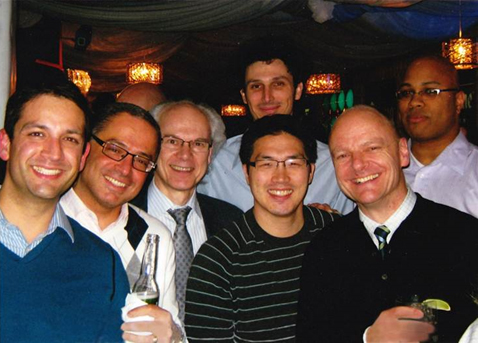
Transplant & HPB Fellows, 2011
Front Row: Pablo Serrano, Ehab Rafael, Peter Kim, Markus Boehnert
Back Row: Paul Greig, Davic Cavallucci, Sylvester Black
The in-patient service of Division of General Surgery at the Toronto General Hospital is housed on 9-Eaton South and has 3 clinical teams of residents & students (HPB, Surgical Oncology & ACS teams).
The Team HPB staff surgeons are Drs. Gallinger, McGilvray, Moulton, Reichman, Sapisochin and Shwaartz. They cross-cover each other on a weekly basis. The Fellow assigned to HPB rounds daily with the staff surgeon, HPB designated PA, and resident, and has limited transplant activity during that 3 month block.
Faculty rotating on the Surgical Oncology team are Drs. Cattral, Ghanekar, Sayed and Selzner.
The in-patient ward includes a 6-bed acute care unit for early post-op HPB cases. Patients requiring ventilation and/or pressors are managed in the Medical-Surgical Intensive Care Unit.
Hepatic Surgical Oncology & the Liver Program
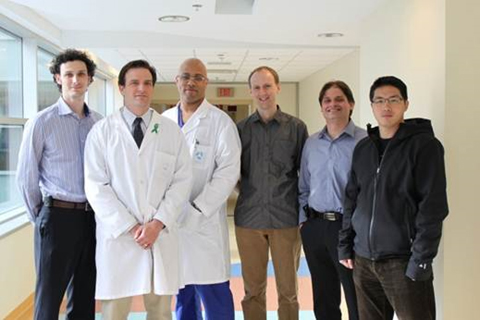
Transplant & HPB Fellows, 2010 David Cavalucci, Trevor Reichman, Sylvester Black, Adrian Fox, George Zogopolous, Peter Kim
The yearly volumes are:
| 2017 | 2018 | 2019 | 2020 | |
| Right hepatectomy+ | 36 | 47 | 49 | 44 |
| Left hepatectomy+ | 29 | 27 | 27 | 23 |
| 2/3 resection | 22 | 14 | 20 | 16 |
| Meso + large non-anatomic | 49 | 53 | 53 | 48 |
| Segmental + “wedge” | 41 | 30 | 20 | 28 |
| TOTAL | 177 | 171 | 169 | 159 |
Hepatic Oncology includes the surgical management of primary hepatic neoplasms (including hepatocellular carcinoma and peripheral cholangiocarcinoma) and secondary lesions (e.g. including colorectal and neuroendocrine metastases). Liver resections range from limited “wedge” resections to formal anatomic resections. For colorectal metastases, resections can be synchronous with the primary resection or metachronously. Staged resections are used for bi-lobar disease. Volumetric assessment of the future liver remnant (FLR) is performed by the HPB & Transplant Fellows using the dedicated Myrian (R) software. Pre-operative portal vein embolization is used to facilitate hypertrophy of the FLR. Intra-operative ultrasound is facilitated by the diagnostic radiologists in the OR. Most thermal ablation of hepatic neoplasms (RFA or microwave) is performed transcutaneously by the Interventional Radiologists. Approximtely 30% of liver resections are performed laparoscopically, including formal right and left hepatectomies.
Liver transplantation for hepatocellular carcinoma constitutes approximately 30% of all transplant activity. Deceased donor liver transplant is facilitated by MELD exception points for tumors that fulfill the Ontario criteria (i.e. the UCSF criteria or Total Tumor Volume+ AFP criteria). For patients whose tumors exceed the Ontario criteria, living donor liver transplant is an option if the tumor(s) fulfill the Extended Toronto Criteria.
Pancreatic Surgical Oncology & the Pancreas Program
New patients with pancreatic malignancies are triaged centrally. With programmatic support provided by the McCain Clinic, newly referred patients are managed by a multidisciplinary team of Surgical, Medical and Radiation Oncologists which are coordinated through a weekly MCC.
Patients with resectable pancreatic ductal adenocarcinoma (PDA) are managed by the surgeon. Those with locally advanced lesions are considered for downstaging with neo-adjuvant chemotherapy to facilitate resection, or with combined chemo-radiation to facilitate resection with arterial reconstruction (ARCAP protocol). Post-operative adjuvant chemotherapy is facilitated through the McCain Clinic
Patients with neuroendocrine lesions are managed by a team that includes Neuro-Endocrinologist and the monthly neuroendocrine MCC. The surgical approach to primary and metastatic lesions is augmented by ablation and embolization strategies through collaboration with Interventional Radiology.
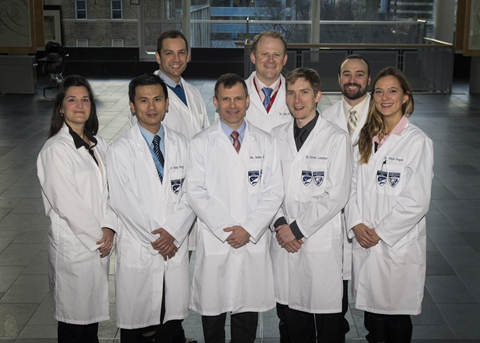
HPB & Transplant Fellows, 2013
Front Row: Amelie Tremblay-St. Germain, Siong Liau, John Seal, Jerome Laurence, Maja Segedi
Back Row: Pablo Serrano, John Conneely, Rory Smoot
The yearly volume of pancreatic procedures is:
| 2017 | 2018 | 2019 | 2020 | |
| Whipple | 107 | 93 | 68 | 78 |
| Distal | 52 | 38 | 36 | 28 |
| Total pancreatectomy | 14 | 6 | 4 | 8 |
Biliary Oncology & the Biliary Program
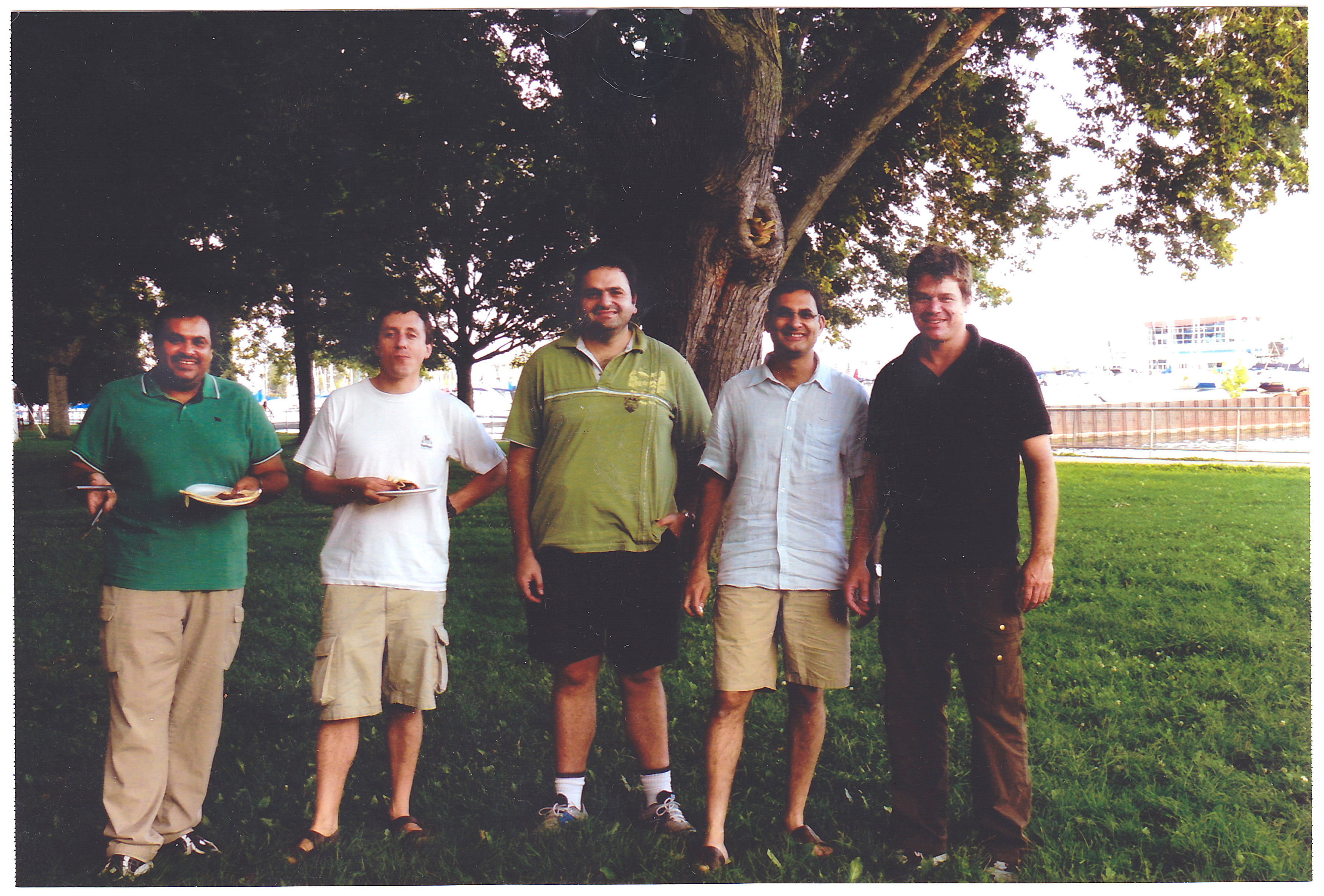
HPB & Transplant Fellows, 2008
Dr. Hamad al-Bahili, Dr. Rodrigo Iñiguez-Ducci, Dr. Charbel Sandroussi, Dr. Sulaimen Nanji, Dr. Markus Guba
Through strong collaboration with local interventional endoscopists (ERCP and EUS), patients with mid-and upper 1/3 obstructing biliary lesions are managed by the 6 surgeons. Weekly MCC are held to facilitated the multdiciplinary management.
Carcinoma of the gall bladder may present as an incidental finding in the laproscipic cholecystectomy specimen, or as a mass lesion, often obstructing the mid-third of the bile duct. A resection, appropriate for the stage, is usually indicated.
The management of hiilar cholangiocarcinoma (Klatskin tumor) is based on stage and local extent. For tumors that are unresectable on the basis of involvement of the contralateral hepatic artery, consideration is given to neo-adjuvant chemo-radiation and transplantation (The “Mayo protocol”) or arterial resection & reconstruction.
Non-oncologic biliary surgery includes procedures for benign biliary conditions including repair of duct injuries that occur at the time of laparoscopic surgery, and surgical management of recurrent pyogenic cholangitis (RPC) and choledochal cysts. The yearly volume of procedures for benign conditions ranges from 43 – 48 per year.
The Liver Transplant Program
The Liver Transplant Program functions within the Ajmera Transplant Centre of the University Health Network (UHN) and the Toronto General Hospital (TGH) and the Pediatric Academic Multi-Organ Transplant Program (PAMOT) of the Hospital for Sick Children (HSC).
The staff are:
- 6 Surgeons: Drs. Cattral, Grant, Ghanekar, McGilvary, Reichman & Selzner
- 5 Hepatologists: Drs. Bhatt, Lilly, Galvin, Selzner & Patel
- 6 Surgical Fellows: 4 Transplant Fellows (2 first year and 2 second year) and the first year HPB Fellow and the non-Matched Fellow
- 4 Hepatology Transplant Fellows
- 3 Nurse Practitioners: Ms. Healey, Sawicka & Tarani
- 1 Physician Assistant
- Junior Resident in General Surgery
- Medical Student in Transplant
The adult program serves approximately 75% of the province of Ontario (13.5M), and most patients from the province of Manitoba, and the pediatric program serves all of Ontario, Manitoba, and approximately half of the Maritimes. The program volumes for 2014 were:
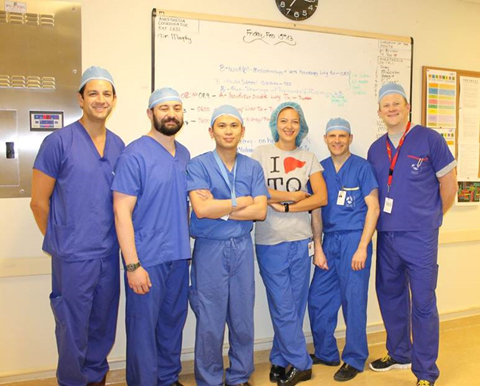
HPB & Transplant Fellows, 2013
Pablo Serrano, Rory Smoot, Siong Liau, Maja Segedi, John Seal, John Conneely
| Adult deceased donors | 133 |
| Adult live donors | 42 |
| Pediatric deceased donors | 25 |
| Pediatric live donors | 30 |
| Total | 217 |
The Toronto Living Donor Liver Transplant program is the largest in North America with approximately 50 adult and 20 pediatric LDLTs per year, and over 600 LDLTs to-date.
The majority of the adults receive right lobe grafts, and children receive left lobe grafts. Over 200 potential donors are assessed each year and the Fellows perform all the volumetric analyses using the Myriam Software on dedicated computers. The living donor hepatectomy and transplantation are an important part of our teaching curriculum and the Fellows actively participate in the donor and recipient transplant procedures.
Clinics in Surgical, Medical & Radiation Oncology
Clinics are an essential component in the education and training in HPB Oncology. Each first year Fellow is expected to attend an out-patient clinic for a minimum of one day per week. Through 3 monthly assignments with 2-3 staff surgeons, continuity of patient care is maintained for the Fellow from the clinic to the OR and to the post-operative management. In the HPB Fellow’s second year, Surgical Oncology Clinics are augmented with 3 month rotations in GI Medical Oncology Clinics and GI Radiation Oncology Clinics.


